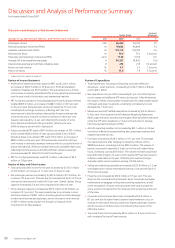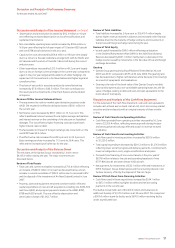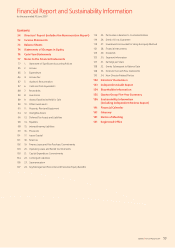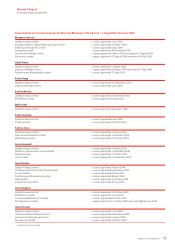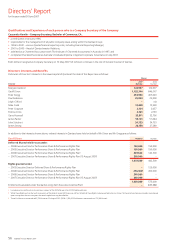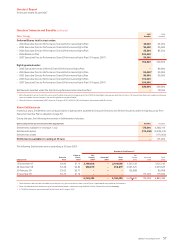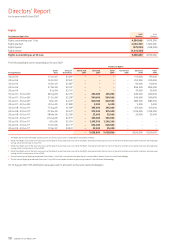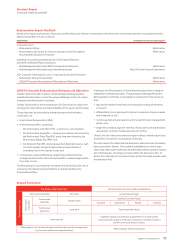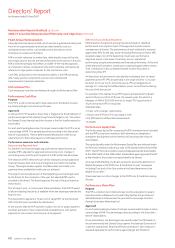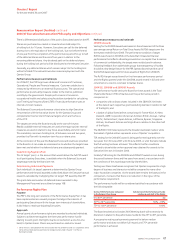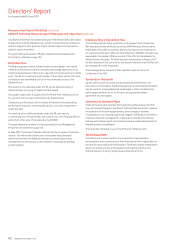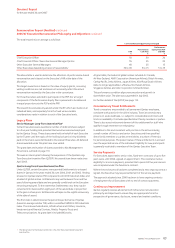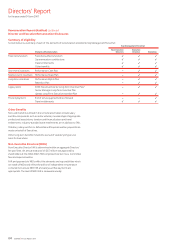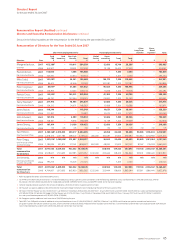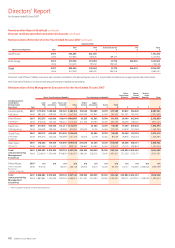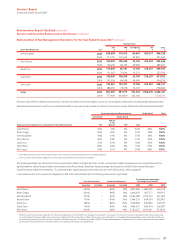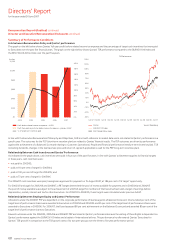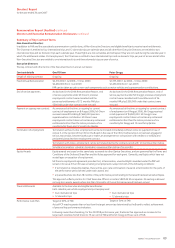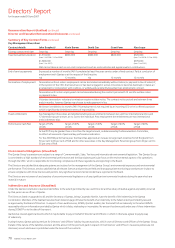Qantas 2007 Annual Report Download - page 62
Download and view the complete annual report
Please find page 62 of the 2007 Qantas annual report below. You can navigate through the pages in the report by either clicking on the pages listed below, or by using the keyword search tool below to find specific information within the annual report.60 Qantas |Annual Report 2007
Directors’ Report
for the year ended 30 June 2007
Fixed Annual Remuneration
Salary decisions are based on FAR, which involves a guaranteed salary level
from which superannuation and certain other benefits, such as a
maintained motor vehicle, can be deducted at the election of the
employee on a salary sacrifice basis.
FAR is set with reference to market data, reflecting the scope of the role,
the unique value of the role and the performance of the person in the role.
FAR is reviewed annually and reflects a middle-of-the-market approach,
as compared to similar comparative roles within Australia, with particular
reference to large public companies for the most senior roles.
Cash FAR, as disclosed in the remuneration tables, is the FAR remaining
after salary sacrifice components such as motor vehicles and
superannuation have been deducted.
Performance Plan
Cash and equity incentives are delivered through the Performance Plan.
Performance Cash Plan
Purpose
The PCP is a cash incentive paid to Executives when the Qantas Group’s
key financial target is achieved over the year.
Approach
A cash pool for PCP awards to Executives is triggered if a threshold level of
performance against the Qantas Group financial target is met. This means
the Qantas Group financial result for the year is the first hurdle required to
be satisfied.
For each participating Executive, the target reward under the PCP is set as
a percentage of FAR. This percentage varies according to the Executive’s
level of responsibility. There is differentiated distribution of the bonus
payment pool to Executives based on individual performance.
Performance measures and rationale
Determining Payment Pool
For 2006/07, the financial target was profit before related income tax
expense (PBT) adjusted for approved restructuring costs, changes in
accounting policy and the profit impact of A-IFRS ineffective derivatives.
The selection of PBT reflects the use of this measure as a key budget and
financial measure both at Group and segment level within the Qantas
Group. This single measure applies to all Executives and results in no
payment when profitability hurdles are not achieved.
The target is set annually as part of the budgeting process and approved
by the Board. At the conclusion of the year, the adjusted PBT result is
provided to the Board. The Board approves the size of the pool based on
these results.
The ‘at target’ pool, i.e. the amount that would deliver the full PCP award
to all participating Executives, is available when the target approved by the
Board is met.
The threshold for payment is 75 per cent of target PBT. At the threshold,
half of the PCP pool is available for distribution.
In the six years that the PCP has been in place, the full ‘at target’ payment
has been achieved on two occasions and exceeded twice, with partial
payment on one occasion and one year of nil payment.
Determining Individual Payments
Differentiation of payments among Executives based on individual
performance is an important part of the approach to performance
management at Qantas. The performance of each individual is assessed
against their KPIs for the year, and an Individual Performance Factor (IPF)
assigned at year end. At the beginning of each year, performance
objectives are set in the areas of customer service, operational
performance, people achievements and financial performance. At the end
of the year each Executive’s contribution is assessed against these criteria.
Their contribution is also considered relative to other Executives in
determining their IPF.
An Executive’s actual reward is calculated by multiplying their ‘at target’
payment by their IPF. IPFs are generally in the range of 0.8 to 1.2 but can
be down to 0 or up to 2.0. Across the group, IPFs are targeted to an
average of 1, ensuring that differentiation occurs, but without increasing
the cost of the bonus pool.
For example, if the Qantas Group PBT target is achieved and the Board
award 100 per cent of the PCP pool, the reward under this plan for a
Manager on FAR of $120,000 with an ‘at target’ PCP opportunity of
10 per cent and an IPF 0.9 would be:
$120,000 (FAR)
x 10 per cent (‘at target’ opportunity)
x 100 per cent (PCP pool if Group target is met)
x 0.9 (IPF based on differentiated assessment)
= $10,800.
Performance Equity Plan
The Performance Equity Plan comprises the PSP (a medium-term incentive)
and the PRP (a long-term incentive). Both elements are designed to
strengthen the alignment of the interests of Executives with those of
shareholders.
The equity benefits under the Performance Equity Plan are delivered under
the Terms & Conditions and various rules of the Qantas Deferred Share Plan
(DSP). The DSP Terms & Conditions were initially approved by shareholders
at the 2002 AGM. At the 2006 AGM, shareholders again approved the DSP
as the vehicle for the provision of equity benefits by Qantas.
At its July 2006 Meeting, the Board resolved to amend the definition of
Eligible Employee in the DSP Terms & Conditions to read “employees
(including Directors) of the Group whom the Board determines to be
eligible for an offer.”
There have been no other changes to the DSP Terms & Conditions during
the year.
Performance Share Plan
Purpose
The PSP is a medium-term deferred share incentive designed to reward
Executives when a Balanced Scorecard of key Qantas Group measures
(detailed below) is achieved over the year and to encourage retention
through a two year deferral period.
Approach
For each participating Executive, the target reward under the plan is set as
a percentage of FAR. This percentage varies according to the Executive’s
level of responsibility.
On an annual basis, the Board approves awards under the PSP based on
the achievement by the Qantas Group against the Balanced Scorecard of
Customer, Operational, People and Financial measures. Each measure is
assessed separately for performance against target and threshold.
Remuneration Report (Audited) continued
2006/07 Executive Remuneration Philosophy and Objectives continued


